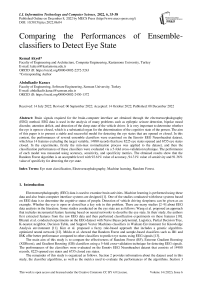Comparing the Performances of Ensemble-classifiers to Detect Eye State
Автор: Kemal Akyol, Abdulkadir Karaci
Журнал: International Journal of Information Technology and Computer Science @ijitcs
Статья в выпуске: 6 Vol. 14, 2022 года.
Бесплатный доступ
Brain signals required for the brain-computer interface are obtained through the electroencephalography (EEG) method. EEG data is used in the analysis of many problems such as epileptic seizure detection, bipolar mood disorder, attention deficit, and detection of the sleep state of the vehicle driver. It is very important to determine whether the eye is open or closed, which is a substantial organ for the determination of the cognitive state of the person. The aim of this paper is to present a stable and successful model for detecting the eye states that are opened or closed. In this context, the performances of several ensemble classifiers were examined on the Emotiv EEG Neuroheadset dataset, which has 14 features excluding the target variable, 14980 records that have 8225 eye states opened and 6755 eye states closed. In the experiments, firstly the min-max normalization process was applied to the dataset, and then the classification performances of these classifiers were evaluated via a 5-fold cross-validation technique. The performance of each model was measured using accuracy, sensitivity, and specificity metrics. The obtained results show that the Random Forest algorithm is an acceptable level with 92.61% value of accuracy, 94.31% value of sensitivity and 91.36% value of specificity for detecting the eye state.
Eye state classification, Electroencephalography, Machine learning, Random Forest
Короткий адрес: https://sciup.org/15018914
IDR: 15018914 | DOI: 10.5815/ijitcs.2022.06.04
Список литературы Comparing the Performances of Ensemble-classifiers to Detect Eye State
- A. Vallabhaneni, T. Wang, B. He, "Brain-Computer Interface," In: He, B. (eds) Neural Engineering. Bioelectric Engineering. Springer, Boston, MA., 2005, pp. 85–121.
- H. Javaid, R. Manor, E. Kumarnsit, S. Chatpun, "Decision Tree in Working Memory Task Effectively Characterizes EEG Signals in Healthy Aging Adults," IRBM Innotive Research Biomedical Engineering, 2021, In Press.
- B. Ari, N. Sobahi, Ö.F. Alçin, A. Sengur, U.R. Acharya, "Accurate detection of autism using Douglas-Peucker algorithm, sparse coding based feature mapping and convolutional neural network techniques with EEG signals," Comput Biol Med, 2022;, vol. 143, pp. 1-10.
- D. Sunaryono, R. Sarno, J. Siswantoro, "Gradient boosting machines fusion for automatic epilepsy detection from EEG signals based on wavelet features," J King Saud Univ - Comput Inf, Sci 2021. In Press.
- İ. Yıldız, R. Garner, M. Lai, D. Duncan, "Unsupervised seizure identification on EEG," Comput Methods Programs Biomed, 2022, vol. 215, pp. 1-9.
- W. Al-Salman, Y. Li, P. Wen, F.S. Miften, A.Y. Oudah, H.R.A. Ghayab, "Extracting epileptic features in EEGs using a dual-tree complex wavelet transform coupled with a classification algorithm," Brain Res, 2022, vol. 1779, pp. 1-15.
- A.N. Pusarla, B.A. Singh, C.S. Tripathi, "Learning DenseNet features from EEG based spectrograms for subject independent emotion recognition," Biomed Signal Process Control, 2022, vol. 74, pp. 1-12.
- C. Li, B. Wang, S. Zhang, Y. Liu, R. Song, J. Cheng, et al., "Emotion recognition from EEG based on multi-task learning with capsule network and attention mechanism," Comput Biol Med, 2022, vol. 143, pp. 1-11.
- Arjun, A.S. Rajpoot, M.R. Panicker, "Subject independent emotion recognition using EEG signals employing attention driven neural networks," Biomed Signal Process Control, 2022, vol. 75, pp. 1-11.
- T. Wang, S.U. Guan, K.L. Man, T.O. Ting, "EEG eye state identification using incremental attribute learning with time-series classification," Math Probl Eng, 2014, vol. 2014, pp. 1-10.
- S. Bharati, P. Podder, M. Raihan-Al-Masud, "EEG Eye State Prediction and Classification in order to Investigate Human Cognitive State," 2018 Int Conf Adv Electr Electron Eng ICAEEE 2018 2019. https://doi.org/10.1109/ICAEEE.2018.8643015.
- Y.M. Kim, C.Y. Lee, C.G. Lim, "Computing Intelligence Approach for an Eye State Classification with EEG Signal in BCI," Software Engineering and Information Technology, 2016, pp. 265–270.
- M. Sahu, N.K. Nagwani, S. Verma, S. Shirke,"Performance Evaluation of Different Classifier for Eye State Prediction Using EEG Signal," Int J Knowl Eng, 2015, vol. 1, pp. 141–145.
- O. Roesler, "UCI Machine Learning Repository: EEG Eye State Data Set," 2013. https://archive.ics.uci.edu/ml/datasets/EEG+Eye+State (accessed March 2, 2022).
- P. Qin, L. Zhao, Z. Liu,"State of health prediction for lithium-ion battery using a gradient boosting-based data-driven method," J Energy Storage, 2022, vol. 47, pp. 1-23.
- M. Sipper, J.H. Moore,"AddGBoost: A gradient boosting-style algorithm based on strong learners," Mach Learn with Appl, 2022, vol. 7, pp. 1-4.
- M. Wang, X. Li, M. Lei, L. Duan, H. Chen, "Human health risk identification of petrochemical sites based on extreme gradient boosting," Ecotoxicol Environ Saf, 2022, vol. 233, pp. 1-8.
- C. Bentéjac, A. Csörgő, G. Martínez-Muñoz, "A comparative analysis of gradient boosting algorithms," Artif Intell Rev, 2021, vol. 54, pp. 1937–1967.
- L. Zhou, H. Fujita, H. Ding, R. Ma, "Credit risk modeling on data with two timestamps in peer-to-peer lending by gradient boosting," Appl Soft Comput, 2021, vol. 110, pp. 1-12.
- L. Breiman, "Random forests," Mach Learn, 2001, vol. 45, pp. 5-32.
- S. Georganos, T. Grippa, A.N. Gadiaga, C. Linard, M. Lennert, S. Vanhuysse, et al., "Geographical random forests: a spatial extension of the random forest algorithm to address spatial heterogeneity in remote sensing and population modelling," Geocarto International, vol. 36, no. 2, pp. 121–136.
- N. Farnaaz, M.A. Jabbar, "Random Forest Modeling for Network Intrusion Detection System," Procedia Comput Sci, 2016, vol. 89, pp. 213–217.


